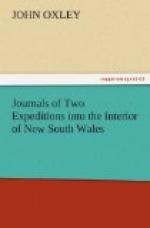The soil, in the immediate neighbourhood of Bathurst, is for the first six inches of a light, black, vegetable mould, lying on a stratum of sand, about eighteen inches deep, but of a poor description, and mixed with small stones, under which is a strong clay. The surface of the hills is covered with small gravel, the soil light and sandy, with a sub-soil of clay. The low flats on the immediate borders of the river are evidently formed by washings from the hills and valleys deposited by floods, and the overflowings of the watercourses.
Sunday, April 20.—Proceeded on our journey towards the Lachlan River. At two o’clock we arrived at the head of Queen Charlotte’s Valley, passing through a fine open grazing country; the soil on the hills and in the vale a light clayey loam, occasionally intermixed with sand and gravel: the late rains had rendered the ground soft and boggy. The trees were small and stunted, and thinly scattered over the hills, which frequently closed in stony points on the valley. The rocks a coarse granite.
Monday, April 21.—Our journey for the greater part of the way lay over stony ridges, and for the last six miles over a country much wooded with ill-grown gum and stringy bark trees (all of the eucalyptus genus); the grass good, and in tolerable plenty, and much more so than the appearance of the soil would seem to promise. At three o’clock, the horses being very much fatigued, we stopped under the point of a rocky hill for the evening.
April 22.—A clear and frosty morning. Last night was the coldest we had yet experienced, the thermometer being at six o’clock as low as 26. We felt the cold most severely, being far beyond what we had been accustomed to on the coast; the difference of temperature in twelve hours being upwards of twenty degrees of cold. Our route lay through a dull uninteresting country, thickly covered with dwarf timber, daviesia, etc. Passed under Mount Lachlan, a hill of very considerable height; a stream of water runs north-westerly under its base. Turned off a little from our track to the right, and ascended Mount Molle, whence there is a beautiful and extensive prospect from the south by the west to the north. The country (except the dividing range between the Lachlan and Macquarie Rivers, which is very lofty and irregular) rising into gentle hills, thinly timbered, with rich intervening valleys, through which flow small streams of water. I think from Mount Molle, between the points above mentioned, a distance of forty miles round may he seen; the view to the west being lost in the blue haze of the horizon, no hills appearing in that quarter. The Mount itself is a fine rich hill, favourably situated for a commanding prospect; the valleys which surround it are excellent land, well watered with running streams. We descended its west side, and stopped for the night in the valley beneath, on the banks of a small rivulet.




